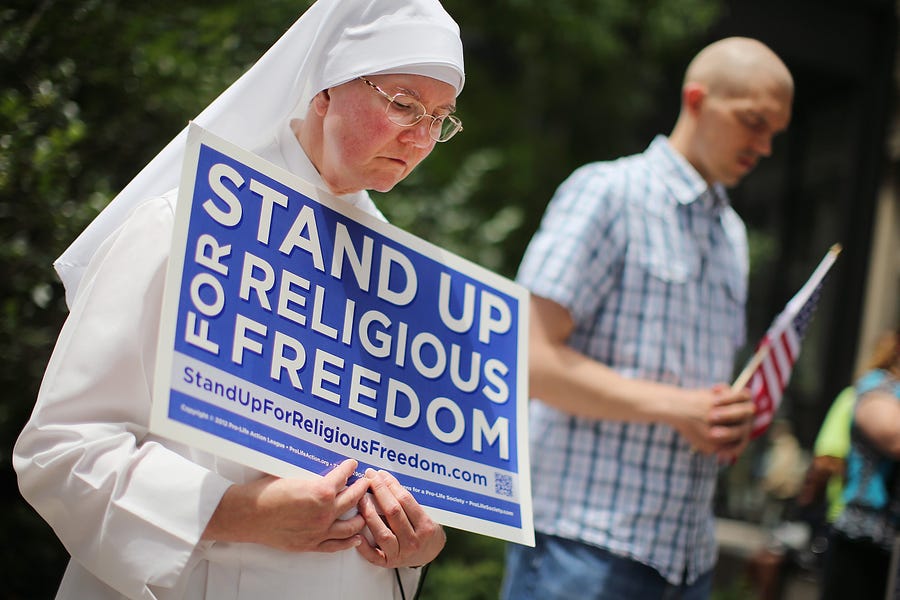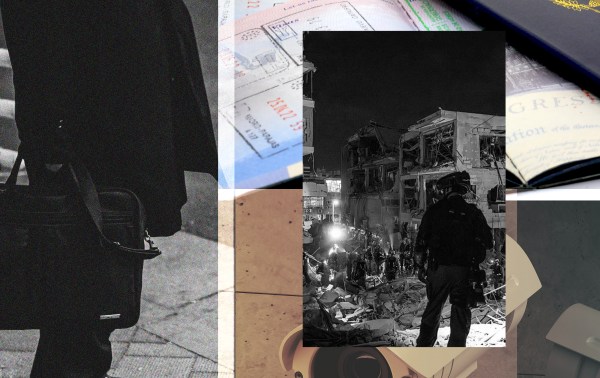I have seen a remarkable amount of commentary in the aftermath of the Supreme Court’s decision in Bostock v. Clayton County arguing that the Supreme Court dealt religious liberty in America a serious, dangerous blow. Bostock, for those who don’t follow SCOTUS case names closely, is the case that interpreted Title VII’s prohibition against discrimination on the basis of “sex” to necessarily include sexual orientation and gender identity.
As I read piece after piece, I realized that many of the people writing about the impact on religious freedom simply didn’t understand the law. A generation of Americans raised on breathless activist warnings about freedom’s demise genuinely believe that religious organizations teeter on a dangerous precipice. They genuinely believe that free speech hangs in the balance. While liberty is under pressure (it always is—every single material liberty recognized and secured by the Bill of Rights faces constant, sustained pressure from an expanding state), its reach is still vast.
Warning—what follows is a detailed legal discussion that just might bore you. But if you’re interested, power through. And feel free to share this newsletter with your concerned friends, your concerned pastor, or your worried school principal.
I’m going to outline the key federal statutory and constitutional protections for religious liberty and religious Americans that exist now, today, after Bostock and why I believe that, if anything, many of these protections are more likely to be extended, not restricted, in the coming days and weeks. So, here goes:
Religious employers have a right to impose religious litmus tests on their employees. Title VII of the Civil Rights Act of 1964—the same statute at issue in Bostock—contains a provision specifically designed to protect the autonomy of religious organizations. It states, “This subchapter shall not apply … to the employment of individuals of a particular religion to perform work connected with the carrying on by such corporation, association, educational institution, or society of its activities.”
It’s true that this carveout does not allow the religious organization to discriminate on other grounds (such as race or sex), but it does allow them to filter out all applicants who do not share the group’s faith. This has a profound impact on the relevant applicant pool and (along with the First Amendment) permits employers to require that applicants agree to the organization’s statement of faith.
Religious employers are completely exempt from nondiscrimination statutes when hiring and firing “ministerial” employees. The ministerial exception may well be the key firewall protecting church from state. Put simply, and as defined by a unanimous Supreme Court in 2012, both the Free Exercise and Establishment clauses of the First Amendment work together to remove the state—including all nondiscrimination laws—from the ministerial selection process.
The precise definition of a “ministerial employee” is presently before the Supreme Court. The key question is the extent to which the employee performs “important religious functions” and whether an employee’s title and training must also reflect those functions.
It’s clear the exemption applies to called and trained clergy. By the end of the court’s term, it’s likely also to apply to a broader range of religious employees who are engaged in religious instruction.
Religious educational institutions enjoy a right to exempt themselves from Title IX. If there’s a single question I’ve received more than any other, it’s this: Does Bostock mean that religious schools will now have to alter policies regarding dorm rooms or sexual conduct to comply with federal prohibitions against sexual orientation and gender identity discrimination?
The short answer is no. The longer answer is nope, not unless they choose to be subject to Title IX, the federal statute that prohibits sex discrimination in federally funded educational programs and activities.
To be clear, Bostock is an employment case (and thus the sections above apply to employment at religious schools), but one would expect that the definition of “sex” applied in Title VII would also extend to Title IX, thus preventing sexual orientation and gender identity discrimination in, for example, codes of conduct, dorm placements, and athletic programs. .
But Title IX contains a special carveout:
[T]his section shall not apply to an educational institution which is controlled by a religious organization if the application of this subsection would not be consistent with the religious tenets of such organization.
The exemption is not automatic. Schools have to choose to opt out (either proactively or in response to a Title IX complaint), and a number of religious schools have taken advantage of this provision. Many have not, but it is their choice, and that choice is plainly and clearly embedded in federal law.
Religious organizations (including religious schools) increasingly have a right of equal access to public funds. Few areas of constitutional litigation have been more relentlessly successful than the attempt to claw away at illegitimate and discriminatory attempts to relegate faith-based organizations to second-class status. For years, the argument that there had to be a “high wall of separation” between church and state—words that appear nowhere in the Constitution—meant that religious organizations could not participate in otherwise-neutral state-funded programs simply because they were religious.
The Supreme Court has taken a jackhammer to that idea. Key cases include:
Rosenberger v. Rectors and Visitors of the University of Virginia (1995). SCOTUS held that a Christian publication on campus had a right of viewpoint-neutral access to student fee funding. (During my legal practice, I used that precedent to help secure millions of dollars in funding for Catholic and Evangelical student groups—including funding that directly applied to efforts to evangelize the campus.)
Zelman v. Simmons-Harris (2002). The Supreme Court held that a Cleveland, Ohio, school voucher program did not violate the Establishment Clause by permitting religious schools to be voucher recipients. This cleared the way for the state to fund (through vouchers distributed to parents) faith-based education as part of a larger program designed to increase school choice.
Trinity Lutheran v. Comer (2017). In a 7-2 decision, the Supreme Court held that the state of Missouri violated the Free Exercise Clause when it excluded a church from receiving a grant as part of a secular and neutral state program designed to make children’s playgrounds safer.
Critically, the court will soon decide yet another case involving state aid to religious schools, Espinoza v. Montana Department of Revenue. In Espinoza, the court will decide whether it’s lawful to “invalidate a generally available and religiously neutral student-aid program simply because the program affords students the choice of attending religious schools.”
In plain English, if SCOTUS rules for the plaintiff in the case, then it will place one of the final nails in the coffin of anti-Catholic “Blaine Amendments”—state constitutional provisions that blocked aid to “sectarian” institutions as part of a transparent effort to preserve a Protestant monopoly on public funds.
Religious organizations enjoy a right of equal access to public facilities. I don’t need to spend much time on this category, but many younger Americans might be shocked to find out that it was once an open question whether Christian groups had a right to meet in empty classrooms or gymnasiums on the same basis and with the same access as secular groups.
A series of cases, from Widmar v. Vincent (1981) to Lamb’s Chapel v. Center Moriches Union Free School District (1993) to Good News Club v. Milford Central School (2001) blasted open access at every level of education, from elementary schools to colleges and universities. And now tens of thousands of student groups and even churches meet (often for free or for nominal fees) and preach the Gospel from public lands.
Religious Americans are protected from discrimination in the workplace. You might look at all the paragraphs above, and say, “That’s all well and good, but I’m not worried about the government. I’m worried about my employer.” Well then, you’re in luck. The same civil rights act that now protects LGBT Americans also explicitly protects people of faith. Remember, Title VII protects against discrimination on the basis of race, sex, and religion. Here’s the scope of that protection, as outlined by the Equal Employment Opportunity Commission:
With respect to religion, Title VII prohibits:
-
treating applicants or employees differently based on their religious beliefs or practices—or lack thereof—in any aspect of employment, including recruitment, hiring, assignments, discipline, promotion, and benefits (disparate treatment);
-
subjecting employees to harassment because of their religious beliefs or practices—or lack thereof—or because of the religious practices or beliefs of people with whom they associate (e.g., relatives, friends, etc.);
-
denying a requested reasonable accommodation of an applicant’s or employee’s sincerely held religious beliefs or practices—or lack thereof—if an accommodation will not impose more than a de minimis cost or burden on business operations; and,
-
retaliating against an applicant or employee who has engaged in protected activity, including participation (e.g., filing an EEO charge or testifying as a witness in someone else’s EEO matter), or opposition to religious discrimination (e.g., complaining to human resources department about alleged religious discrimination).
It is quite true that the case law interpreting and applying Title VII religious discrimination claims to private employers is not nearly as extensive as the case law applicable to race or sex. There’s a simple reason for that—employers have not engaged in large-scale religious discrimination the in same way that they’ve engaged in race and sex discrimination. People of faith have largely been left alone in the workplace.
That can change, of course, and there is anecdotal evidence (“anecdata”) that it is changing, but if discrimination does occur, people of faith have a potent legal weapon in their back pocket.
Religious Americans enjoy the protection of a federal “super statute.” I’m using Justice Neil Gorsuch’s words to describe the Religious Freedom Restoration Act, a law that hovers over and above all other federal laws, providing extraordinary protection to people of faith.
That’s the law that in 2014 permitted Hobby Lobby to opt out of part of the Obamacare contraception mandate.
That’s the law that this year protected progressive immigration activists from criminal prosecution for trespassing on federal lands to leave food and supplies for illegal immigrants crossing a desolate portion of Arizona’s border with Mexico.
And speaking of super statutes, I haven’t even touched the Religious Land Use and Institutionalized Persons Act, a federal law passed in the last year of the Clinton administration that has granted countless local congregations special protection from hostile zoning boards and planning commissions.
Finally, keep a close eye on the next term of the Supreme Court. SCOTUS has accepted for review Fulton v. City of Philadelphia. The petitioners in Fulton seek protection from a Philadelphia rule that required a Catholic foster care agency to provide written endorsements for same-sex couples (in violation of church teaching) as a condition of participating in the city’s foster care system.
In addition, the petitioners are asking the court to revisit Employment Division v. Smith, a 1990 Supreme Court opinion that substantially restricted the strength and scope of the Free Exercise Clause. If the petitioners prevail, it could well represent the most significant advance for religious liberty in decades.
Look again at all the elements above. Yes, it is true that in some respects religious liberty is “under siege.” There are activists and lawmakers who want to push back at multiple doctrines and some radicals even dream of revoking tax exemptions from religious organizations that maintain traditional teachings on sex and gender. But if the siege is real, then so is the citadel. People of faith in the United States of America enjoy more liberty and more real political power than any faith community in the developed world.
Look also at something else. Why did I include the dates of each court decision? Because they demonstrate that the effort to find, cultivate and confirm originalist and textualist jurists has borne legal fruit. There are those who decry the conservative legal movement as a “failure” after the Bostock decision. This is simply untrue. The conservative legal movement is one of the most successful legal movements in modern American history.
In the face of progressive control of the vast majority of the legal educational establishment, conservatives have created, sustained, and nurtured an intellectually vibrant and determined community of lawyers, scholars, and judges who have transformed American law to better match the meaning and text of the American Constitution. It has not accomplished all it could (what movement ever does?)—and there have been bitter disappointments—but it has made an enormous impact by securing liberties that American Christians now take for granted.
Yes, in spite of legal successes many people of faith face profound cultural headwinds (not on all fronts, however, the pro-life movement has made immense strides, which we—again—totally take for granted). But those headwinds do not exist because the law failed us. The law has given every religious American, every religious organization, and every church or synagogue all of the liberty they need to speak words of truth and grace into our fallen culture..
The question for America’s religious community, then, is not whether we have liberty—or will have liberty for the foreseeable future—but rather what we do with that liberty. As John Adams declared, “Our Constitution was made only for a moral and religious People. It is wholly inadequate to the government of any other.” I’m afraid that while the church has been consistently religious, it has not been consistently moral. And in its political witness it seems to grow less moral by the day. We cannot expect the law—or any other arm of the state—to heal the church’s self-inflicted wounds.
I’ve spent the vast bulk of my professional life standing guard on the citadel of free exercise and free speech, working to expand its walls and hardening its fortifications. But that citadel exists for a purpose beyond its mere continued existence. It is supposed to empower the church to fearlessly act as salt and light in a broken world. I’m reminded, however, of Christ’s words in the Sermon on the Mount:
You are the salt of the earth, but if salt has lost its taste, how shall its saltiness be restored? It is no longer good for anything except to be thrown out and trampled under people’s feet.
In many quarters of American religion, a trampling is underway. It is not the law’s fault that the church faces a reckoning, and even as we seek to preserve and strengthen our legal citadels, we must remember that it won’t be the law that brings repentance and awakening. May God grant churches the grace and wisdom to use wisely and for his kingdom the abundant liberties they now possess.
One last thing …
Every now and then—especially in times of sorrow and certainty—it’s vital to remember the absolute sovereignty of God—to remember that in his will “all is well.” This song is by Robin Mark, and it’s been blessing me for more than a decade. Enjoy:
Photo by Scott Olson/Getty Images.







Please note that we at The Dispatch hold ourselves, our work, and our commenters to a higher standard than other places on the internet. We welcome comments that foster genuine debate or discussion—including comments critical of us or our work—but responses that include ad hominem attacks on fellow Dispatch members or are intended to stoke fear and anger may be moderated.
With your membership, you only have the ability to comment on The Morning Dispatch articles. Consider upgrading to join the conversation everywhere.